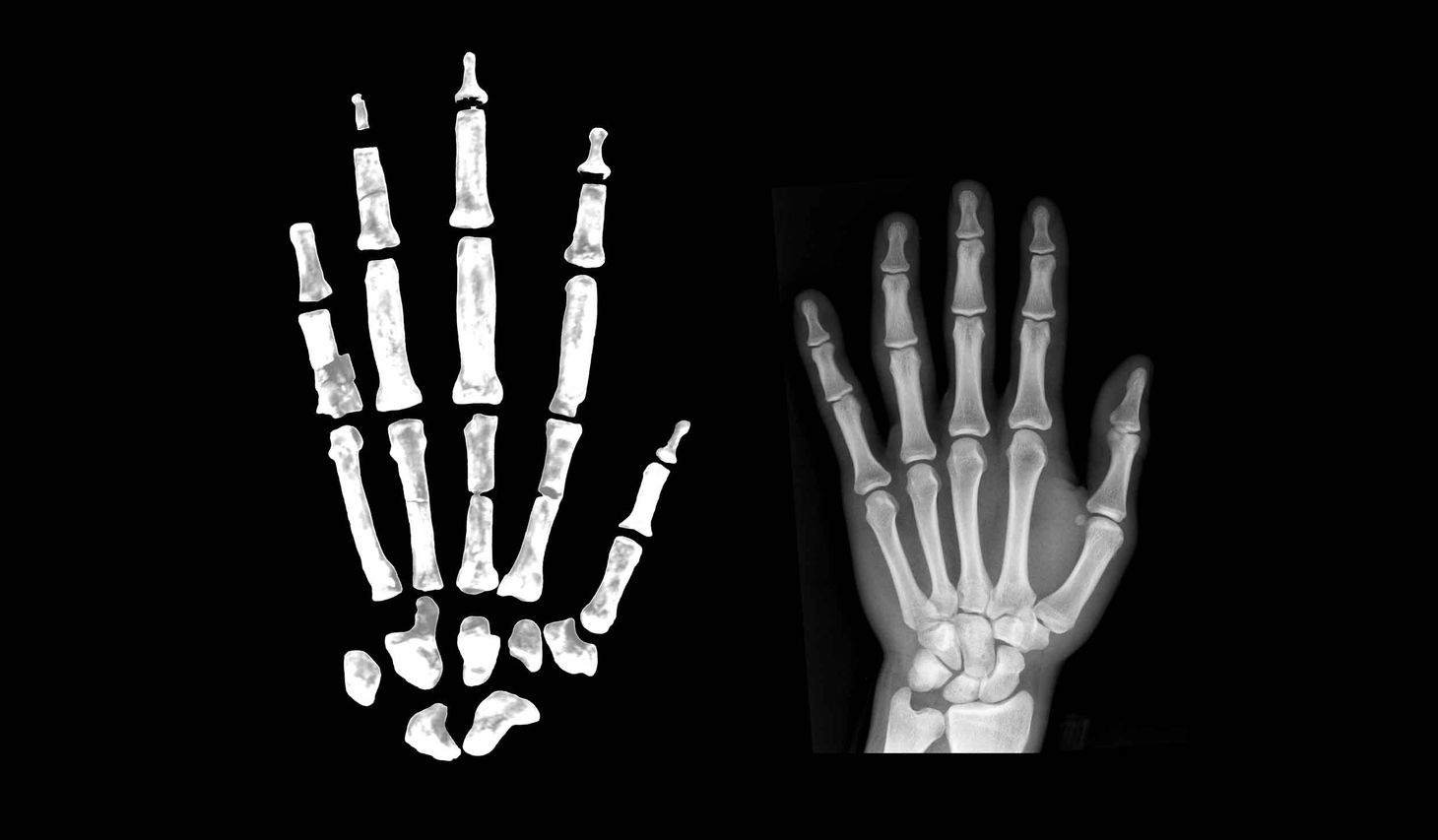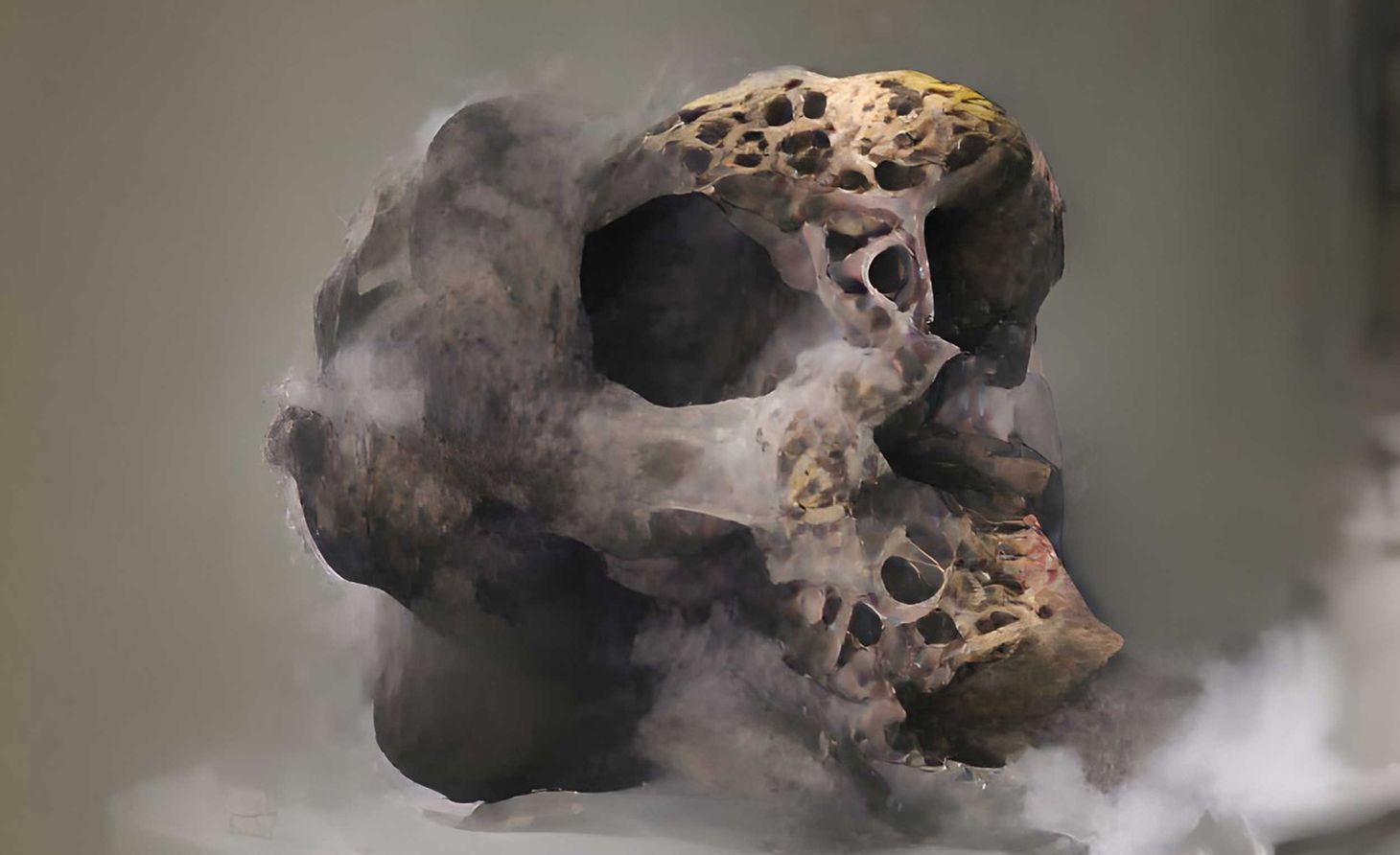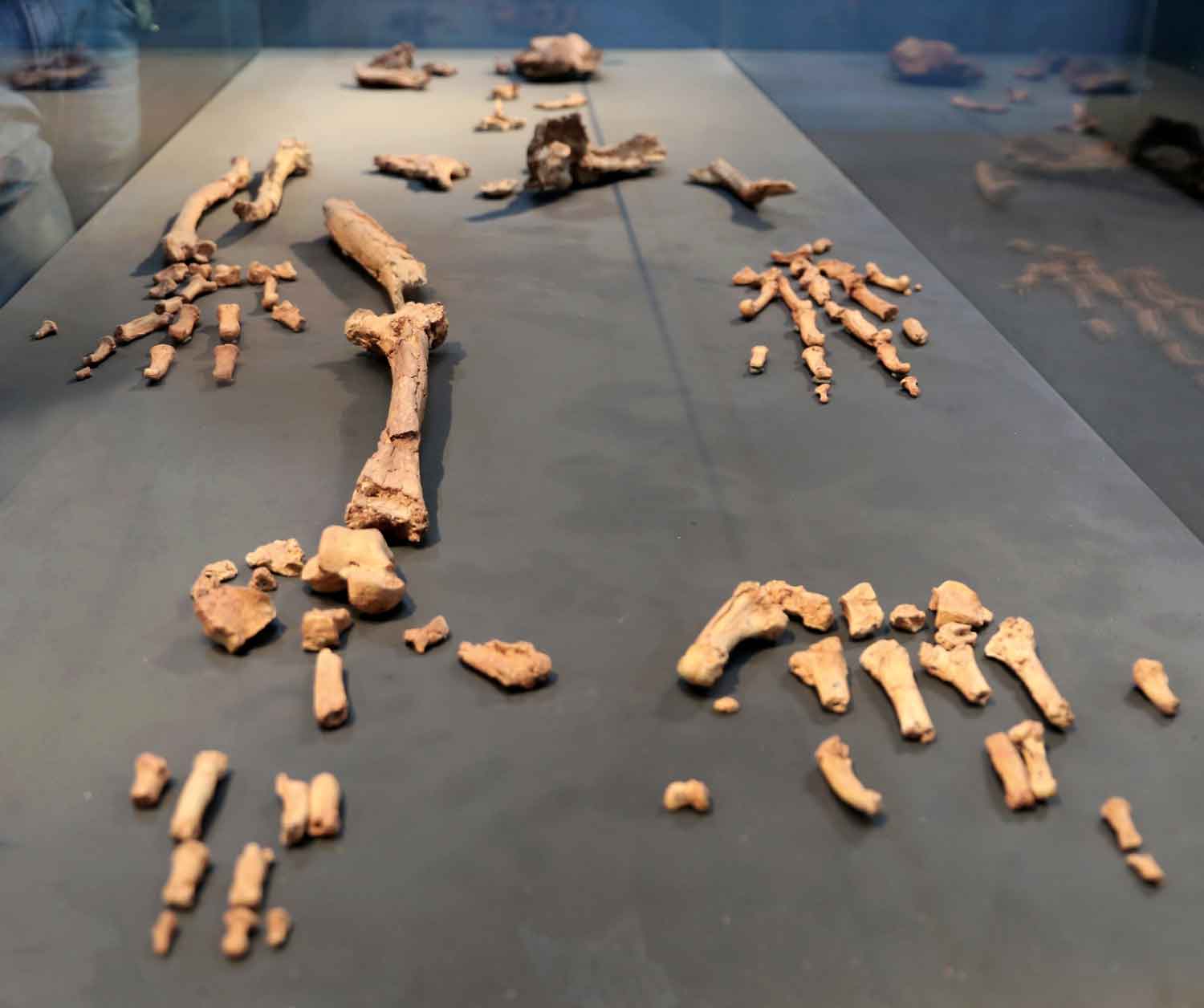Ardipithecus ramidus remains from a second field region, As Duma
New research from Sileshi Semaw and coworkers describes new fossils between 4.5 and 4.3 million years old.

Paleoanthropologist Sileshi Semaw has a new paper in Nature describing fossils of Ardipithecus from the Gona research area in Ethiopia. Semaw is a researcher at the CRAFT Stone Age Institute at the University of Indiana.
The fossils come from a locality called As Duma, and likely date to between 4.3 and 4.5 million years ago, based on stratigraphic and paleomagnetic considerations. The remains are mostly dental, with three substantially preserved dentitions and several isolcated teeth. There is also a fragment of mandibular corpus and a mandibular ramus matched with one of the mandibular series. Otherwise, there are three hand bones (phalanges) and one toe bone.
Is there evidence for bipedality?
As is the case for other remains from Ardipithecus, here it is argued that the toe bone represents a biped, because the proximal articular facet is oriented upward (dorsally). This means that the toes were characteristically dorsiflexed rather than plantarflexed, and therefore were used for walking but not substantially for gripping objects.
Why are the fossils assigned to Ardipithecus?
The teeth resemble known dental remains of Ardipithecus. General similarities include the size of the postcanine teeth, the height of the upper and lower canines, and the diamond-like shape of the upper canine in labial view (the broadest mesiodistal point is about halfway between the apex and base of the crown). These features are not entirely compelling because of the notable variability among early australopithecines, including A. anamensis and A. afarensis. According to Semaw and colleagues,
The P4 crown is mesiodistally compressed with an oval plan, a simple cusp pattern and a single root matching the Aramis (Ethiopia) specimens of Ardipithecus ramidus and distinct from the triangular/quadrangular cervical cross-section of Australopithecus multi-rooted P4.
In other words, the fossils "fit" well with Ardipithecus by virtue of their anatomy and date, and have at least one tooth crown that is fairly distinctive.
Is there any other Ardipithecus insight?
The evolving story of Ardipithecus is that it is a likely ancestor of later hominids. Contrast this with the situation in 1995, shortly after the initial announcement of both Ardipithecus ramidus and Australopithecus anamensis. These two hominid species overlapped in time, but had clear anatomical differences. Although Ardipithecus had an earlier range of dates (4.1 million to 4.4 million years ago according to White et al. 1994), it was viewed to be morphologically distinct from all later hominids, in particular having molars that were described as smaller, with thinner enamel and more chimpanzee-like morphology than any known australopithecine.
But being described as "chimpanzee-like" has obfuscated much about the anatomy of Ardipithecus. Consider the dental features of A. afarensis compared to living apes and humans: it has thick molar enamel, large molars, molars that increase in size posteriorly, canines that are variable in height, ranging on the small end to incisor-sized, and on the large end still much shorter than females of living ape species. Australopithecines evolved from apes with large projecting canines. It is unclear whether the Miocene apes that were ancestral to later hominids had thick or thin enamel, or large or small molars, because these traits are variable among Miocene hominoids. But they certainly had smaller molars and premolars than the australopithecines, and could not have matched their enamel thickness. Therefore, it is exceedingly likely that the early ancestors of the australopithecines had smaller molar sizes, thinner molar enamel, larger canines, and cutting P3's. Compared to A. afarensis these ancestors would be chimpanzee-like in these details.
Is this what the initial description of the Aramis hominids described? In their description of the first fossils known for the species, White and colleagues (1994) wrote:
Morphology of the known Aramis canines, however, diverges from that of known apes. The upper canines are slightly less incisiform than homologues of A. afarensis but more incisiform than any ape counter part, with occlusally placed terminations of the mesial and distal apical crests. The visual result of apically placed crown shoulders is a low, blunt canine tooth relative to more projecting ape canines, a morphological condition which may have important evolutionary implications. The Aramis upper canine is large buccolingually, formaing a further contrast with mesiodistally elongate African ape canines. Wear pattern also differs significantly from the ape condition. Mandibular canine wear does not show the pattern typical of great apes. (p. 308)
The broken canines and lower P3 in ARA-VP-1/128 and -6/1 exhibit thin enamel distinct from previously known hominid conditions. Canine enamel thickness approximates the chimpanzee condition, with a lack of apical thickening we observe in other hominids. ... The relatively thin enamel and large size of the Aramis canine, together with its primitive P3 morphology, suggest a C/P3 complex morphologically and functionally only slightly removed from the presumed ancestral ape condition. (p. 308)
The ARA-VP-6/1 P3 is markedly more apelike than any A. afarensishomologue in its high protoconid with extensive buccal face and steep, distolingually directed transverse crest. In these features it is indistinguishable from ape homologues. (p. 308)
Molar morphology resembles the A. afarensis condition, but lacks the extreme buccolingual breadth relative to mesiodistal length common in that species. The 'serrate' root pattern and deep dentine wear on the buccal cusps described in A. afarensis, Tabarin, and Lothagam also occur in Aramis specimens. All molars lack the extensive crenulation and broad occlusal foveae characteristic of modern chimpanzees, or the high cusp topography of gorillas. (p. 309)
On these dental characters, the Aramis hominids do correspond to what we might expect of an ancestor of later hominids. The "chimpanzee-like" character is canine enamel thickness. Other characters are either near or within the range of later hominids, or more apelike. In this context, apelike means that these characters are not specifically similar to any living ape, and indeed the living apes are substantially different from the Aramis remains in several characters. In particular, the chimpanzee-like dm1 is not specifically like chimpanzees, but instead is in the range of all living and fossil apes. This is a plesiomorphy, not a derived similarity with chimpanzees.
Aramis enamel thickness is similar to chimpanzees not only in the canines but also in the molars. But enamel thickness itself is a problematic character. White and colleagues (1994) say:
A distinct difference from known hominids occurs in molar enamel thickness. Maximum radial enamel thickness of crown faces can be measured in three fractured Aramis specimens and it ranges from 1.1 to 1.2 mm buccally, at or near the unworn cusp apex, perpendicular to the enamel-dentine junction. These values are comparable to the uppermost range of our homologous enamel thickness values measured on broken P. troglodytes molars (n=22; M1 through to M3). Equivalent measures in A. afarensisrange from 1.4 to 2.0 mm (n=5). (p. 309)
Of course, this places the Aramis specimens intermediate between chimpanzees and other early hominids. White and colleagues (1994) did not report the range of the chimpanzee comparative sample, so it is hard to say what the import of the enamel thickness of Aramis really is. Haile-Selassie (2001, 180) writes:
Another candidate for hominid ancestry is the recently described Orrorin tugenensis. The authors report thick molar enamel and suggest that Ardipithecus and African apes are commonly derived in having 'thin' enamel. However, enamel thickness is a complex character and intraspecifically variable, and its within-tooth three-dimensional patterning is characteristically expressed both serially and taxonomically. Therefore the simplistic dichotomous characterization of enamel as either 'thick' or 'thin' on the basis of unspecified measurements of naturally broken sections (as was done in the Orrorin report) is problematic.
Of course we can compare this quote with the report of Senut and colleagues (2001, p. 4), "Enamel thickness at the apex on the paraconid [of the BAR 1000'00 left M2] is 3.1 mm. This is comparable to other hominids, Ardipithecus excluded." There certainly does seem to be a difference between the Middle Awash sample and Lukeino in enamel thickness, based on the limited number of examples. It is a shame that the range of variation in living hominoids has not been better reported in the context of these early hominids. But even if everything rises or falls based on enamel thickness alone, we have one sample (Middle Awash) with an intermediate morphology between australopithecines and chimpanzees, and another sample (Lukeino) with an australopithecine-like morphology, which is probably also more similar to earlier Miocene apes like Ouranopithecus.
White and colleagues have clearly moved toward an interpretation of the early hominids in which the taxonomic diversity was minimal. For example, Haile-Selassie, Suwa and White (2004, p. 1505) wrote:
Metric and morphological variation within available small samples of late Miocene teeth attributed to A. kadabba, O. tugenensis, and S. tchadensis is no greater in degree than that seen within extant ape genera. Despite claims of molar enamel thickness differences among these late Miocene fossils, we question the interpretation that these taxa represent three separate genera or even lineages. Given the limited data currently available, it is possible that all of these remains represent specific or subspecific variation within a single genus.
One may point out that if the Asa Koma and Lukeino hominids actually do represent a single species, they are properly referred to Orrorin (or Ardipithecus) tugenensis, rather than A. kadabba. One may speculate that it is for this reason that Haile-Selassie, Suwa and White (2004) focus on the genus level in their argument, since it is at this level that Ardipithecushas priority. It is worth mentioning that the enamel thickness in the A. anamensis molars is more similar to later australopithecines than to Ardipithecus, with measurements around 1.9 mm on the protocone of KNM-ER 30748 (Ward et al. 2001). Again, the measurements here emphasize the problems with comparison of such values, since measurements on fossils are taken where breaks naturally occur, and with the possibility of attrition on the teeth.
At any rate, this argument continues with the discovery of the Gona Ardipithecus remains. According to the BBC, Tim White
agreed it was becoming apparent A. ramidus was an important species that was a very plausible ancestor to later hominids. "It's already clear that we're seeing the basic grade from which Australopithecus evolved," he told the BBC News website.
One feature of these hominids points toward that conclusion--even at the expense of A. anamensis. The reconstruction of the GWM-3/P1 mandible has a shape similar to AL 288-1 (Lucy) with diverging (V-shaped) tooth rows. Semaw and colleagues contrast this morphology with A. anamensis, where the tooth rows are oriented parallel to each other.
Is it possible that the Kanapoi and Allia Bay hominids were a side-branch of an Ardipithecus--A. afarensis lineage? Sure, there is actually little to preclude this scenario beyond the relatively thicker enamel and larger molars of the sample assigned to A. anamensis. It would be helpful to have a full characterization of the variability of these samples as they existed over time, to judge the magnitude of change necessary under different evolutionary scenarios.
But there is one more point on which White and colleagues (1994) described Aramis as chimpanzee-like: the basicranium.
The ARA-VP-1/125 and -1/500 specimens represent adult temporal and occipital regions. Both are smaller than their A. afarensis counterparts, but no female temporal is known for that species. The Aramis cranial fossils evince a strikingly chimpanzee-like morphology that includes marked pneumatization of the temporal squama which even invades the root of the zygoma. (p. 310)
And the postcranial remains are described as displaying "a mosaic of characters usually attributed to hominids and/or great apes" (p. 311). In fact, the known postcrania are an area of resemblance between Ardipithecus and A. anamensis, since both these samples appear to have relatively long forelimb bones compared to later hominids (this comparison is imperfect since body size is not known from other evidence). And the basicranium of A. anamensis was probably similar to Aramis, considering that the KNM-KP 29281 temporal appears to have been pneumatized in the same areas as its Aramis counterpart where it is preserved (Ward et al. 2001). Much appears to have been similar between these two samples, just as much is similar among the earlier hominid samples.
Is this a single lineage changing over time? That would be an appropriate null hypothesis to pursue, and there is little evidence tending to refute it now.
References
Semaw S, Simpson SW, Quade J, Renne PR, Butler RF, McIntosh WC, Levin N, Dominguez-Rodrigo M, Rogers MJ. 2005. Early Pliocene hominids from Gona, Ethiopia. Nature 433:301-305. Full text at Nature
John Hawks Newsletter
Join the newsletter to receive the latest updates in your inbox.



